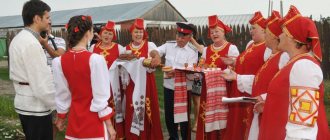Today, it is quite common to hold various themed weddings. But, nevertheless, most newlyweds want to have a real Russian wedding, with all its details observed.
This article will discuss all the features of traditions and customs of celebrations in the Russian style. And in order to have a wedding according to the Russian scenario, you need to familiarize yourself with all the features in detail. After all, such a holiday has long been famous for the scope of fun, which consisted of several stages.
Matchmaking
Each wedding was preceded by the custom of matchmaking. Both relatives and specially hired matchmakers could come to the house of the future bride for matchmaking, who often selected the couple themselves. Most often, the groom did not have the opportunity to see his betrothed until the wedding day. They came to the house closer to sunset in order to avoid the evil eye. They started the conversation with distant topics, using merchant or trade vocabulary. After the matchmakers left, the household tied pokers and grips together “at random.”
Afterwards, the parents came to check the house of the future spouse. They carefully inspected the household and decoration of the house. At times, they even refused to hand over their daughter if they were not satisfied with the conditions of her future detention.
The bride, with a successful outcome of the matchmaking, became withdrawn, wore the simplest clothes, and spoke little. There was a period of “dying,” a transition to a new life.
Sexual relationships in traditional Russian marriage[edit | edit code]
Sexual relations between a man and a woman outside of marital ties violate Christian ethics: Christians consider gender relations to be “holy and pure” only in a marriage sanctified by the Church. “Love sweets,” if their goal is not the birth of children, are perceived by Russians within the framework of Christian ethics as a great sin. The socio-economic conditions of life in the Russian village also played a role in the formation of popular ideas about the value of marriage. Among them, the main one was the land factor. A full-fledged peasant farm could develop normally only if it had both male and female hands. Field work, with the exception of the harvest, collecting firewood, repairing buildings and tools were the responsibilities of the man. Cooking, caring for livestock, raising children, and providing clothing for family members were considered women's work. A peasant who lived outside of marriage was unable to perform the entire volume of necessary agricultural and household work. Russian legislation also played a role in shaping ideas about the need for marriage bonds, according to which arable and hay lands could be provided for the use only of men who had reached the age of eighteen. At the same time, a married person received twice as much land as a single person. Married women worked on land allocated by the community for the “male soul,” and old maids were left without any means of subsistence.
Engagement, bachelorette and bachelor parties
The next step is handshake or engagement. Everyone gathered at one table, feasted, and the father of the future wife announced the solemn event. This was followed by the blessing of the parents and the details of the upcoming wedding were discussed.
Preparations for the intended day included the creation of a dowry by the bride. The basis of the dowry was home textiles embroidered by the girl’s hands.
The custom of going to the bathhouse on the wedding day was mandatory. The participants in this event were the bride herself, relatives and girlfriends. They sang songs, wailed, and in some regions of Russia, the bathhouse was visited by a healer who collected droplets of sweat and then added them to the groom’s drink at the wedding.
Symbolically saying goodbye to her friends, the bride gathered a bachelorette party. Sad songs were sung on behalf of the betrothed, and cheerful ones from the girlfriends. And of course, the Russian wedding ceremony is unbraiding the braid. It marked the end of her old life.
The bachelor party for the groom and friends was usually organized by the father, uncle or brother. It took place in the betrothed's house and was accompanied by its own songs and gatherings.
On the groom's side, a groom was appointed who, to a certain extent, led the action. The friend knew the customs well: when it was necessary to pronounce sentences, and most importantly, he was trusted to come to his betrothed’s house and assess her readiness for the wedding. His distinctive sign was an embroidered towel thrown over his shoulder.
The wedding night.
Despite the fact that the essence of this event has changed greatly, there are still couples who still attach importance to it. Romantic atmosphere, beautiful linen, music - young people strive to make this night extraordinary. True, there are those who claim that they slept soundly throughout their wedding night, because a wedding is still a tiring event.
Be that as it may, one thing is good: now the groom’s relatives do not check in the morning whether the bride was a girl before the wedding. Personal remains personal – that’s right.
Wedding day
When the groom arrived, accompanied by relatives and guests, the road along which they were to travel was carefully swept. Under no circumstances could they allow the evil eye to occur.
Nobody was going to give up the bride just like that. A certain auction was held, also known as a ransom. The subjects included not only the betrothed, but also passage along the wedding road, which was blocked in advance, the opportunity to enter the house, the right to the first night, wreaths, and a dowry. Either girlfriends or parents accepted the payment.
Before the wedding, the parents blessed the newlyweds with an icon and bread. The young people entered the church, holding one scarf with their hands. After the church ritual, they were given half a bagel and an apple. On their way out, they stepped over a lock, which they latched and threw into the river.
The wedding feast on the first day took place at the groom's house. To deceive the brownie, the red fellow carried his wife in his arms, like a child. All guests were invited to a rich table, sang songs and had fun. Tables covered with snow-white tablecloths were most often arranged in the letter “G” and relatives were seated according to the degree of relationship.
If you lived in Rus' 200 years ago, then at a wealthy wedding you were treated to:
- noodle soup with pork or chicken;
- borscht or cabbage soup;
- a pancake loaf or chicken chicken with meat (for each piece, please give a coin to the bride-to-be);
- jelly;
- hot;
- stuffed pike;
- beer, wine, mash and spicy honey.
Without fail, the number of dishes served had to be even. This promised happiness and good luck in life together. During the feast, the bride and groom did not eat anything; their cutlery was tied with a ribbon as a sign of unity. And they dined separately, just before their wedding night.
After sunset, the newlyweds were laid on a bed prepared by the matchmaker. The bride herself took off the groom's shoes, recognizing his primacy in the family. But there was always a coin in the boot, which she took for herself. Then they were wished health and left alone. They could be “awakened” within a few hours and demand proof of the chosen one’s innocence. In some cases it was a soiled sheet, in others the husband himself confirmed this fact.
On the second day, everyone moved to the bride's house. Here, Russian wedding traditions are about testing the abilities of the new mistress of the house. The guests deliberately scattered garbage on the floor to evaluate how good she was at housekeeping. The newly-made wife was already setting the table on her own, sensing the guests with pies, jelly and cabbage soup.
“To my mother-in-law for pancakes.” Sound familiar? This is exactly what the young people did on the third day; went to my mother-in-law's for pancakes. Who would refuse the hospitality of the mother of the bride, who has already prepared roast pig, pancakes and scrambled eggs? A ruble was placed in the middle of the table so that there would be money in the house.
Most often, guests came from afar, and seeing off dear relatives was also accompanied by feasts.
A question of love[edit | edit code]
The question of the love of young people was considered as something of secondary importance. The expression “if you endure it, you fall in love” was perceived by everyone, including young people, as something natural and correct. A guy and a girl, when agreeing to a wedding, rarely felt obvious love or antipathy for each other. Moreover, marriage by passion was not approved by public opinion and was viewed as sinful, devoid of a solid foundation. In general, Russians believed that any passions, be it all-consuming love or all-encompassing hatred, are devilish in nature, and therefore not pleasing to God. The age at which one could marry was determined by ecclesiastical and secular authorities. In the XVII-XVIII centuries. girls could marry from the age of 13, boys - from 15. This provision was legalized by the Synod in 1774. In 1830, by decree of Emperor Nicholas I, the lower limit of marriageable age was determined at 16 and 18 years, respectively. In the second half of the 19th century. Russian girls usually got married at 17-20 years old, boys - at 19-21 years old. After 21 years for a girl and 23 years for a guy, marriage became problematic. Early marriages in popular life were considered very desirable and even necessary. Ethnographer R. Ya. Vnukov explained this desire as follows: “They try to marry younger people - while the sexual instinct drowns out all other considerations in the guy, until the will is weaker, so that he does not marry of his own free will and does not choose an unwanted wife. “Get married younger while you are obedient, but if you get older, you won’t get married” is the worldly wisdom of old people. They want to take a younger, more obedient bride, a half-childish character, a weak body, an inability to work - a good guarantee of the daughter-in-law’s obedience. When the daughter-in-law gets old, she gets stronger, the children will crush her, and she will inevitably resign herself” (Vnukov 1929, 25-26). The real conditions of people's life were quite conducive to early marriages. Newlyweds, according to Russian custom, began their family life in the established household of their husband's parents, without shouldering the burden of worries that they, being too young, could not overcome.
Wedding gifts
Since the wedding, as a celebration, was given a special place in life, gifts were prepared in advance. From early childhood, girls were taught sewing and needlework. She gave gifts not only to her husband, but also to his parents. The mother-in-law received a scarf, and the father-in-law a belt. On the male side, she was given clothes and a casket with rouge and jewelry. And a sheepskin coat and boots were prepared for the mother-in-law and father-in-law.
The guests gave household items to the couple themselves, such as:
- towels, but always white and with straight edges;
- kitchen utensils;
- chickens, piglets, ducks, and the number of donated animals had to be a multiple of 10;
- the eldest male presented the future successor with a whip, as a symbol of the primacy of male power in the house.
Bride ransom.
Today, bride price has turned into entertainment for wedding guests, although many grooms still worry about it and learn the day before the mother-in-law’s birthday and the bride’s passport number. Many couples refuse this tradition because they consider it ugly and useless.
In the old days, the ransom was real. The groom's path to the bride's house was blocked by the entire village. He had to remove logs from the road, fight with his fists and pay serious money before taking the girl.
Ancient signs
Oh, how the Russian people love and honor folk signs! In addition to clearing the road before the arrival of the beloved red fellow, and carrying the bride into the new house in his arms, there are many more mandatory protective rituals:
- In order to deceive the evil spirits, they went to matchmaking in a roundabout way.
- Wedding bells dispersed the evil spirits on the way to the church with their ringing.
- In order for the new family to have more offspring and money, the young were showered with grain or hops.
- For the same benefits, they sat the bride on the fur of a fur coat.
- They took a cup of grain wine with them to church. The priest gave the newlyweds to drink from it 3 times, and then the groom threw the cup on the floor and stomped on it.
- For the wedding ceremony, the bridegroom and bridegroom were chosen to hold the crowns.
- It is especially worth mentioning the vytnitsa, who started songs, seeking support from the guests in order to ward off dark forces.
- Sometimes there was a sorcerer at the wedding. To win his favor, every little whim of his was fulfilled, for example, locking the groom in a dark bathhouse for a while.
- The matchmakers entered the house with their right foot and tapped with their heel.
- While the bride was awaiting her wedding day, she was required to wear a black scarf.
- Each ceremony had its own song. Starting from the moment the bride's father drinks the wine brought by the matchmakers, as a sign of consolidating the marriage agreement, ending with songs to see off relatives.
- During the celebration, a little boy was seated on the bride's lap so that male heirs would be born.
Traditions at modern weddings
The general scheme of the Russian wedding ceremony has been preserved. We still organize an engagement when the groom comes to the house of the bride’s parents and asks for “hand and heart.” This order of proposal came to us from the West, since in Rus' the groom did not arbitrarily ask to marry a certain bride. In addition, it was not permissible to go to the house of the bride’s relatives in person.
In a more free form, hen and bachelor parties migrated from past centuries. As if saying goodbye to a free life, the young “light up to the fullest.” A group of girlfriends usually wear distinctive signs, supporting the future spouse, dressed in a veil.
The wedding train, which moves towards a new social unit, consists of a limousine for the newlyweds and mainly a bus for the guests. All the procession cars are decorated, although not with bells, but with bright and eye-catching accessories.
Buybacks occur at almost every modern wedding. But the main difference between modernity is the adoption of a more humorous form. While previously, the ransom could be several times greater than the bride's dowry and the total amount of all gifts.
Currently, a marriage is officially registered only at the registry office or at the wedding palace. Since 1918, church marriage no longer has legal force. But quite a large number of modern couples undergo a wedding ceremony.
The roles of bridegroom and bridegroom remained the same. Now they are performed by witnesses, but as in the registry office, their presence is not necessary. In addition, it is quite difficult to find guarantors who meet all the requirements of the Orthodox Church.
The marriage ceremony is accompanied by Mendelssohn's march. Of course, there is a certain set of Russian popular wedding songs that are included in the repertoire of every toastmaster. That is, the tradition of accompanying rituals with songs is present to some extent.
We haven't forgotten the showering of candies, cereals and coins. Which, to a certain extent, allows employees of palaces, where littering is strictly prohibited, to earn additional income. They showered the newlyweds with petal fireworks - if you please, give the janitors a fine or a coin.
After registration, in most cases, the newlyweds go for a photo shoot, and the guests go for a walk. Young people go to famous places in their city, release pigeons, which, by the way, came to us from Italian lands. Glasses are prepared in advance to break for good luck; this is our ancient tradition. How about decorating the bridge with your own padlock with a date engraving? We no longer throw them into the river, but carefully photograph them and add them to a thousand or two similar ones.
Guests are already waiting in the restaurant, parents greet the newlyweds with a loaf of salt and the guests let them to the table through a lively corridor to the sounds of a cheerful song and applause.
The friend is already a witness, dressed up with a beautiful ribbon, and not a towel, as before. His role is rather symbolic, but the fate of defending himself from the humorous attacks of the toastmaster sometimes requires a certain amount of courage.
According to tradition, the young people are allowed to break the loaf and determine who will be the boss of the house, and feed each other. The bride and groom no longer sit hungry, but together with the guests they eat dishes prepared by the chefs.
Sometimes gifts are given to touched parents to show their love and respect. Fathers, at the behest of the toastmaster, dance with their daughters, handing them over to the groom. Which is also, obviously, a trend of Western wedding traditions.
During the feast, money is collected from the guests for the firstborn. The main task is to determine the sex of the baby. Next, a great many toasts, wishes, surprises from guests, presentation of gifts.
Most often, close relatives give gifts of either real estate or household appliances, and distant relatives and friends give money. Here the task of the witnesses is to ensure that all the gifts remain safe and sound.
As for the usual “bride kidnapping”, the history of this fun game is not so joyful. During the times of serfdom, a master could send slaves to kidnap a bride from a peasant wedding in order to take possession of the right of the first night. The groom had a chance to buy the bride, but more often than not, there were not enough funds. Nowadays, this is nothing more than a joke designed to amuse and amuse guests.
In fact, there are our old wedding traditions, which, having slightly changed their meaning and execution, have been preserved to this day. But we cannot deny the influence of Western culture. We also loved these cute and funny details. I would like that over time, our traditions would not be forgotten, but would return in more adapted variations. After all, everything new is well forgotten old.
Comments (1)
Christina
Interestingly, the foundations of the modern marriage contract were laid in the Slavic tradition. Thus, the groom who came to live in the bride’s house was called “adoptive son-in-law,” and in the event of the death of his wife, he was obliged to rely on the decision of the relatives of the deceased in the matter of dividing jointly acquired property. The widower could get things from the “bannik”. A bannik was a large twisted bundle into which bedding and a minimal set of underwear and towels were folded. This is where the expression “to seduce the bride” comes from. The rest of the wife's dowry had to be handed over safely to the children, or, due to the latter's lack of property, returned to the house of the bride's parents.
Bride's viewing - Meeting the parents.
The bride's viewing today can be compared with meeting her parents. It does not always occur after a marriage proposal, often even before it. Nevertheless, even now this is a very important moment in the life of every young couple. If a man decides to introduce his beloved to his parents, then he takes the relationship very seriously. The same can be said about the girl.
Each of the couple is usually nervous before the first meeting with the parents of a loved one, prepares for it and wants to make a good impression. Girls are more worried about meeting the mother of their loved one, and men are more worried about meeting her father. How parents evaluate their son or daughter's other half can greatly influence the couple's relationship in the future. If the acquaintance goes well, then the likelihood that the newlyweds will get married greatly increases.











